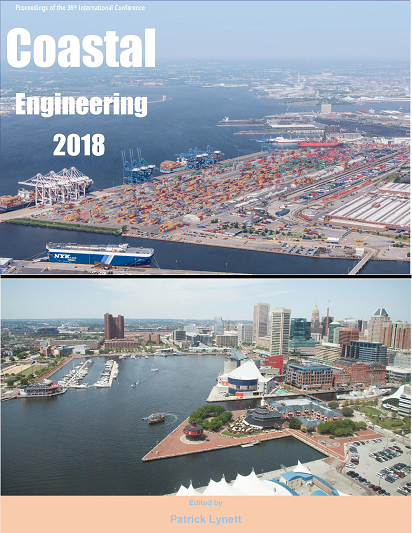Abstract
By carrying out a set of experiments on the responses of vertical concrete/RC walls to tsunami impacts, the characteristics of the responses of concrete/RC walls to tsunami impacts were investigated. Experiments on both the responses of walls to only tsunami wave pressure and those to both tsunami wave pressure and debris collision were carried out. In experiments on the responses only to tsunami wave pressure, flexural failure at the base of the wall was observed when the bending moment at the base of the wall was greater than the predicted cracking moment. In experiments on the responses to both tsunami wave pressure and debris impact, flexural cracks and failure at the base of the wall were observed in some cases, and impulsive oscillations whose frequency immediately after debris collision depended on the debris material were observed.References
Asakura, R., K. Iwase, T. Ikeya, M. Takao, T. Kaneto, N. Fujii, and M. Ohmori. 2002. The tsunami wave force acting on land structures, Proceedings of 28th International Conference on Coastal Engineering, ASCE, 1191-1202.
ASCE. 2016. ASCE 7-16: Minimum design loads and associated criteria for buildings and other structures, ASCE.
Arikawa, T., M. Ikebe, F. Yamada, K. Shimosako, and F. Imamura. 2005. Large model test of tsunami force on a revetment and on a land structure, Annual Journal of Coastal Engineering, JSCE, 52, 746-750.
Haehnel, R.B., and S.F. Daly. 2004. Maximum impact force of woody debris on floodplain structures, Journal of Hydraulic Engineering, 130(2), 112-120.
Kaida, H., N. Kihara, A. Shibayama, D. Takabatake, Y. Miyagawa, and M. Ikeno. 2014. Large-scale experiments on development of fragility assessment method against tsunami wave force and debris impact force in tsunami PRA, Proceedings of the Japan Conference on Structural Safety and Reliability, JCOSSAR 2015. (in Japanese)
Kihara, N., Y. Niida, D. Takabatake, H. Kaida, A. Shibayama, and Y. Miyagawa. 2015. Large-scale experiments on tsunami-induced pressure on a vertical tide wall, Coastal Engineering, 99, 46-63.
Kihara, N. 2016. large-scale tsunami physical simulator: a new type of experimental flume for research on tsunami impact, Hydrolink, 1, 24-25.
Ko, H.S., D.T. Cox, H.R. Riggs, and C.J. Naito. 2014. Hydraulic experiments on impact forces from tsunami-driven debris, Journal of Waterway, Port, Coastal, and Ocean Engineering, 141(3), 04014043.
Naito, C., C. Cercone, H.R. Riggs, and D. Cox. 2013. Procedure for site assessment of the potential for tsunami debris impact, Journal of Waterway, Port, Coastal, and Ocean Engineering, 140(2), 223- 232.
Naito, C., H.R. Riggs, Y. Wei, and C. Cercone. 2016. Shipping-container impact assessment for tsunamis, Journal of Waterway, Port, Coastal, and Ocean Engineering, 142(5), 05016003.
Nistor, I., N. Goseberg, and J. Stolle. 2017. Tsunami-driven debris motion and loads: A critical review, Frontiers in Built Environment, 3, 2.
Shibayama A., Y. Miyagawa, N. Kihara, and H. Kaida. 2018. Response characteristics and nonlinear finite element analysis of RC walls subjected to tsunami wave pressure and driftage collision force, International Journal of Offshore and Polar Engineering (accepted)

